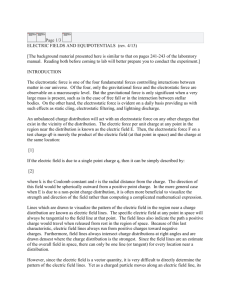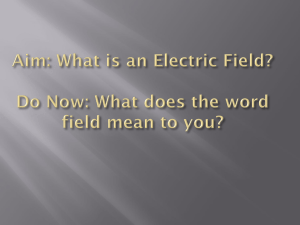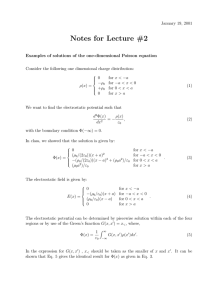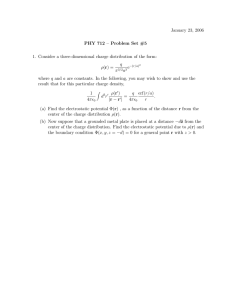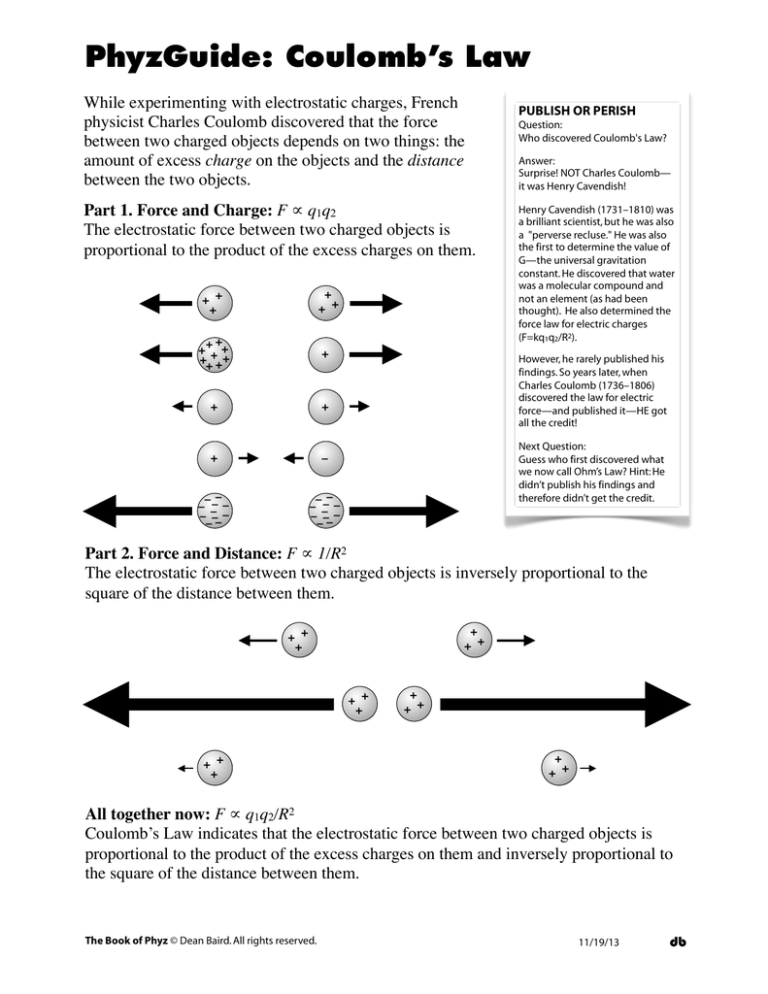
PhyzGuide: Coulomb’s Law
While experimenting with electrostatic charges, French
physicist Charles Coulomb discovered that the force
between two charged objects depends on two things: the
amount of excess charge on the objects and the distance
between the two objects.
Part 1. Force and Charge: F ∝ q1q2
The electrostatic force between two charged objects is
proportional to the product of the excess charges on them.
+ +
+
+ +
+
+
+++ +
+ ++
+
+
+
+
+
–
– –
– –– –
– – –
––
– –
– –– –
– – –
––
PUBLISH OR PERISH
Question:
Who discovered Coulomb's Law?
Answer:
Surprise! NOT Charles Coulomb—
it was Henry Cavendish!
Henry Cavendish (1731–1810) was
a brilliant scientist, but he was also
a "perverse recluse." He was also
the first to determine the value of
G—the universal gravitation
constant. He discovered that water
was a molecular compound and
not an element (as had been
thought). He also determined the
force law for electric charges
(F=kq1q2/R2).
However, he rarely published his
findings. So years later, when
Charles Coulomb (1736–1806)
discovered the law for electric
force—and published it—HE got
all the credit!
Next Question:
Guess who first discovered what
we now call Ohm’s Law? Hint: He
didn’t publish his findings and
therefore didn’t get the credit.
Part 2. Force and Distance: F ∝ 1/R2
The electrostatic force between two charged objects is inversely proportional to the
square of the distance between them.
+ +
+
+ +
+
+ +
+
+ +
+
+ +
+
+ +
+
All together now: F ∝ q1q2/R2
Coulomb’s Law indicates that the electrostatic force between two charged objects is
proportional to the product of the excess charges on them and inversely proportional to
the square of the distance between them.
The Book of Phyz © Dean Baird. All rights reserved.
11/19/13
db
The numerical value of electrostatic force between two charged objects can be
calculated using the equation of Coulomb’s law or the law of electrostatic force:
FE = k q1q2
R2
F is the electrostatic force (newtons)
k is the electric force constant: k = 9×109 N·m2/C2
q1 is the quantity of charge on 1st charge (coulombs)
q2 is the quantity of charge on 2nd charge (coulombs)
R is the distance between the centers of the charged objects (meters)
Coulomb’s law for electrostatic force is very similar to Newton’s law for gravitational
force. One significant difference between electrical and gravitational force is that while
gravitational force is always attractive, electrical force can be attractive or repulsive
(depending on the charges).
Consider this side-by-side comparison of gravitational and electrical force:
Gravity acts between any two objects with mass.
The universal gravitational constant G has very
small magnitude: G = 6.67×10–11 N·m2/kg2.
Electric force acts between any two objects with
charge. The electrostatic force constant k has very
large magnitude: k = 9.0×109 N·m2/C2.
To compare the relative strengths of gravity and electricity, consider those forces as they
act in a hydrogen atom.
Simplified
diagram of a
hydrogen
atom
electron: m = 9.1×10–31 kg
q = –1.6×10–19 C
proton: m = 1.7×10–27 kg
q = +1.6×10–19 C
5.3×10 –11 m
FG = Gm1m2/R2
= 6.67×10–11 N·m2/kg2 (9.1×10–31 kg)(1.7×10–27 kg)
(5.3×10–11 m)2
FG = 3.7 × 10–47 N
FE = kq1q2/R2
= 9×109 N·m2/C2 (–1.6×10–19 C)(1.6×10–19 C)
(5.3×10–11 m)2
FE = –8.2 × 10–8 N
In the hydrogen atom, electric force is ~1,000,000,000,000,000,000,000,000,000,000,000,000,000 (i.e. 1039) times stronger than gravitational force!
The Book of Phyz © Dean Baird. All rights reserved.
db



